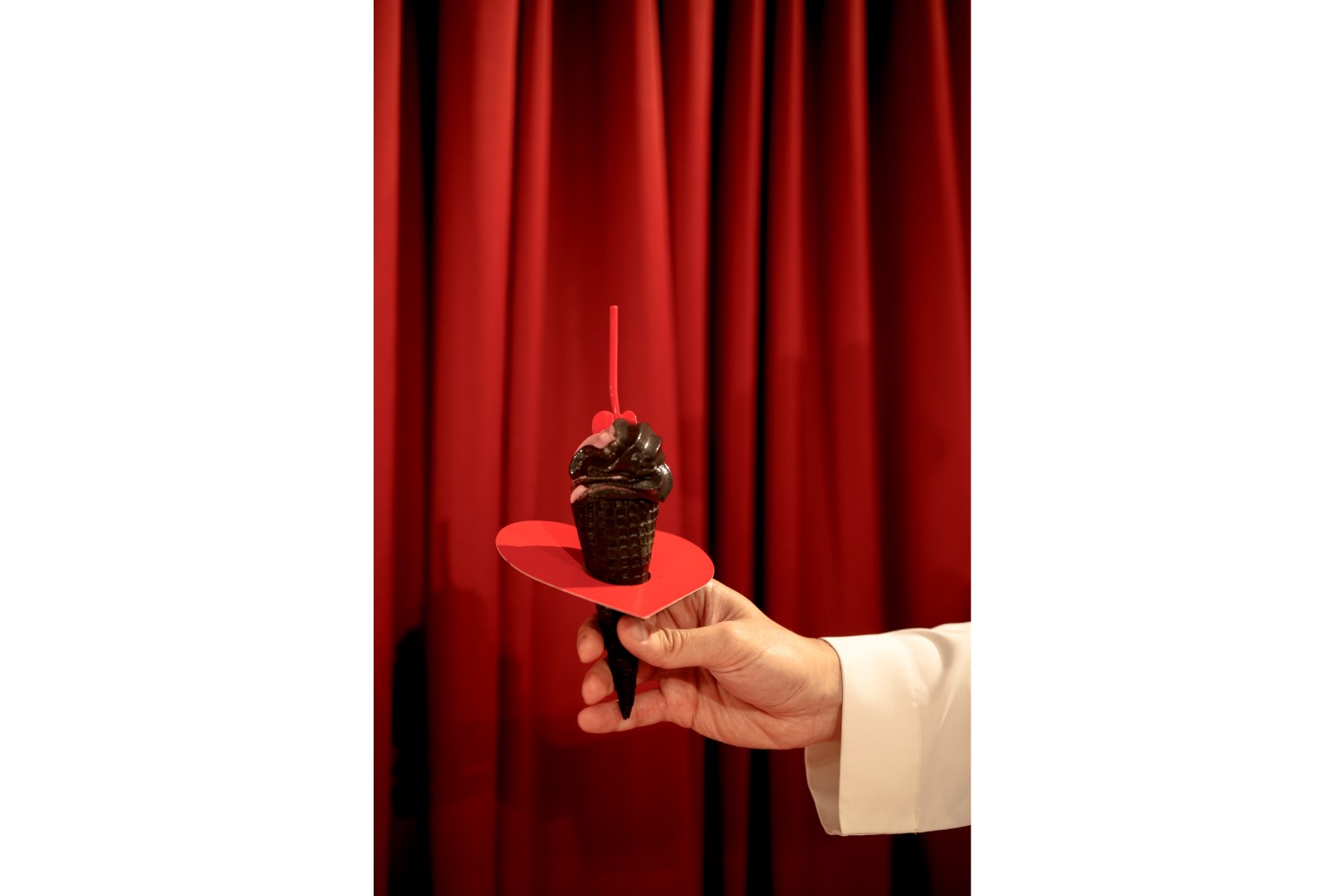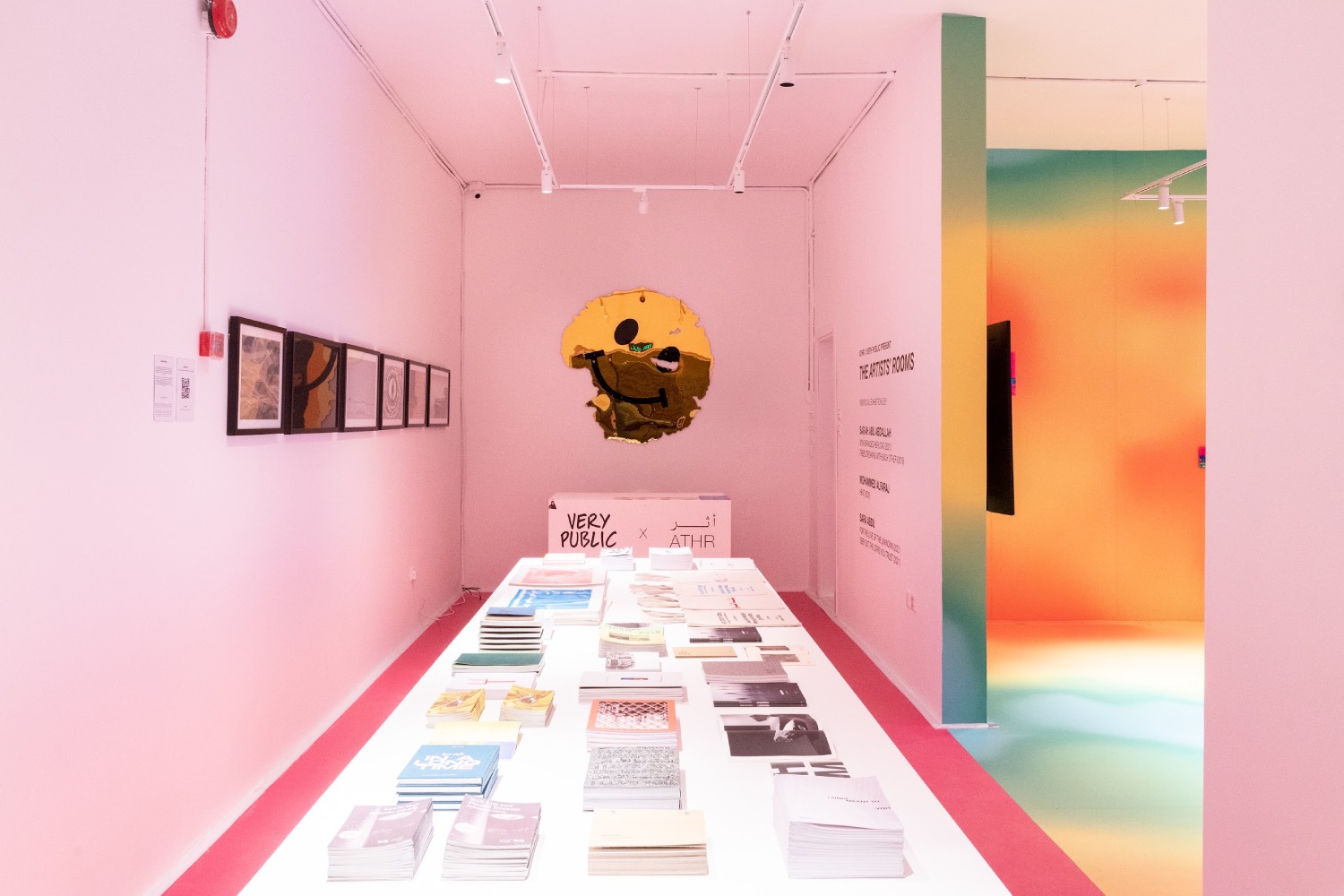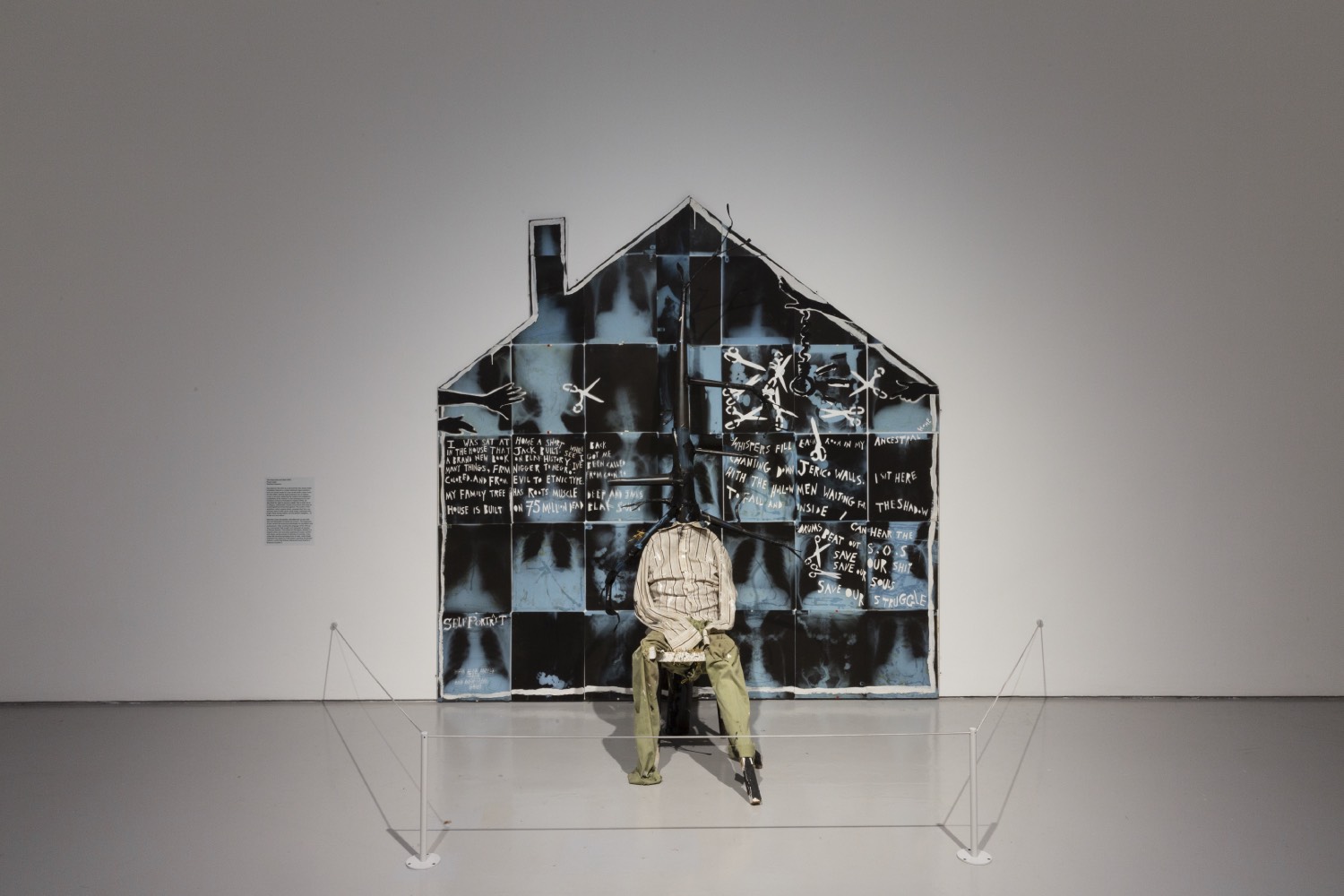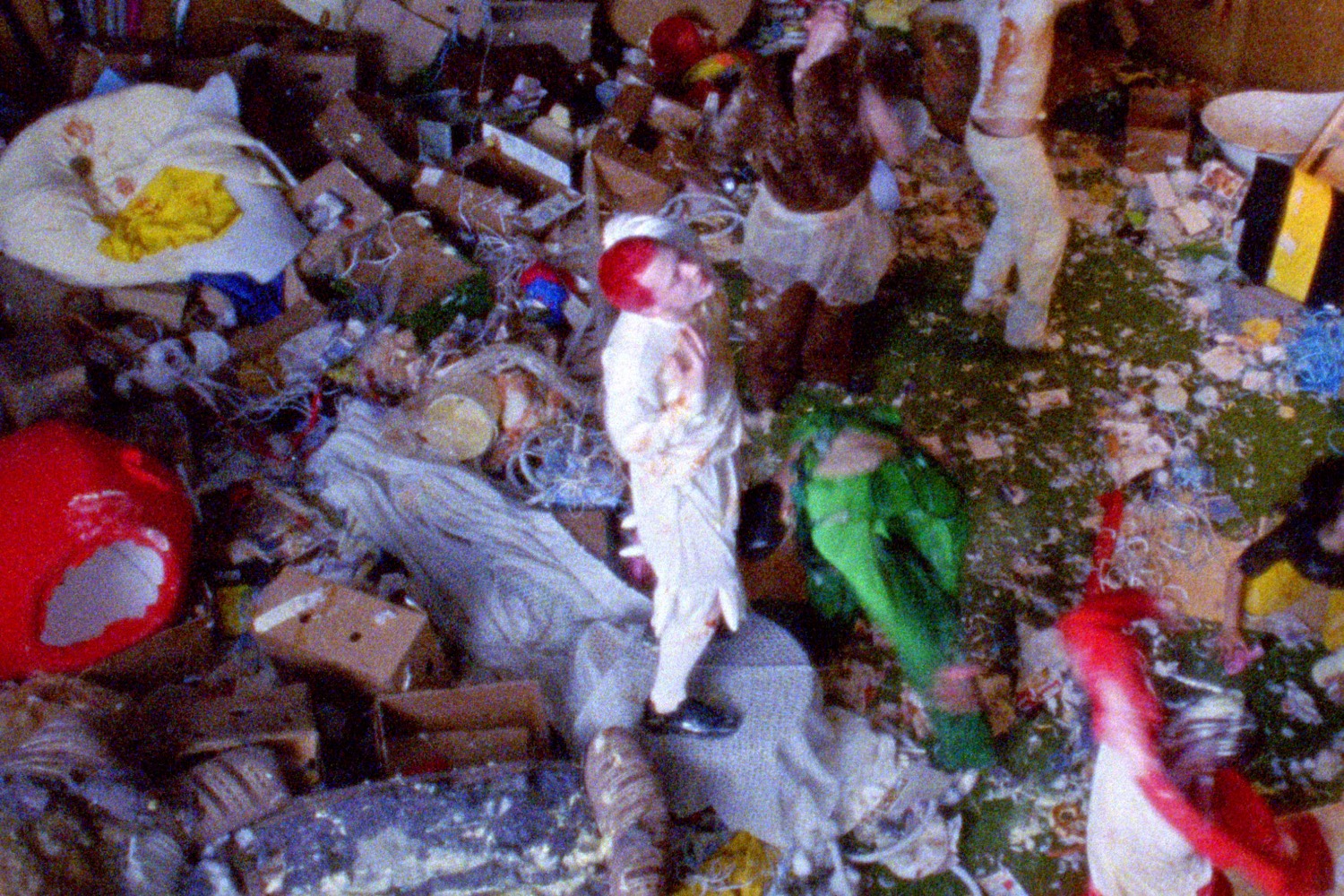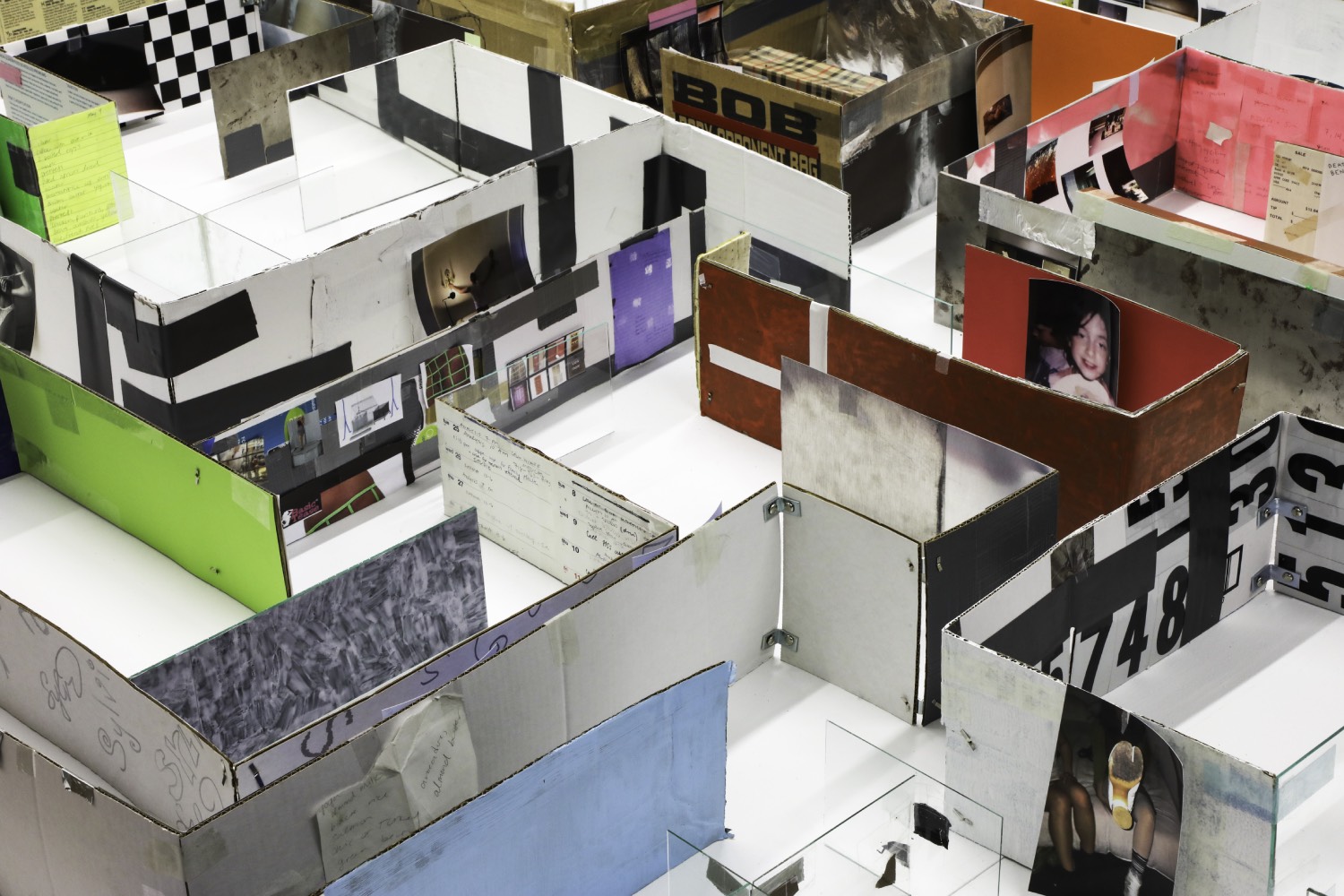It’s about 45ºC on the street. I’m standing between a hardware store and a biryani restaurant, ringing a doorbell amid three persistent stray cats. I’m here to see the new studios of Riyadh’s home-grown artist-run initiative Very Public. The artists/curators behind the initiative, Alaa Tarabzouni and Fahad bin Naif, have recently left their exhibition space and studio of six years in the Diplomatic Quarter and moved closer to the action of the Saudi arts scene’s JAX District. Well, where I am standing (between the cats) is technically not in the highly sought after, repurposed warehouses of the creative community called JAX, but across the street. We’ve started calling these satellite artistic spaces around the district “off-JAX.”
Very Public started as AF Studios in an apartment back in 2018. This studio was a safe space for Alaa and Fahad’s own architectural and artistic practices, but, over the years, it’s evolved into a space for experimental curation and building community. Exhibiting contemporary figures of the art scene — such as Ahmed Mater, Sarah Abu Abdallah, and Aziz Jamal — their shows are known for taking risks. I’m now sitting in the lounge of their new studio space, surrounded by artworks from friends, ashtrays, lighting equipment, and plush furnishings. Very Public is going through a new iteration. The new space is less than half the size of their previous site. We’re discussing the studio’s history, the importance of ARI models for young artists, and the next phase of exhibition-making now that they’ve lost their in-house gallery space. But they have moved to JAX… almost.
Oliver Farrell: Hey, hotties. Could you tell me what the scene looked like in Saudi when you began?
Alaa Tarabzouni: So, it was 2018. We both worked for a public agency, and they were the main fiscal supporters of the arts at the time. Any grant, commission, open call, or scholarship came from them. But we couldn’t apply because we were employees, so it was seen as a conflict of interest. So, we kind of started the studio to create our own opportunity. At the time, I was working on a project that later became JAX, and I brought Fahad in as a consultant for urban development. That’s how we met! I wanted a studio space, so I visited an apartment, took a video, and called Fahad to say, “OK, I’m taking this space. Do you want to go halfsies?” He said yes, and that’s it. After knowing each other for two months.
Fahad bin Naif: We were always sort of on the periphery of this contemporary art movement that started in 2013. Alaa and I have identical CVs — even what we wanted to study. We both wanted to study fine art, but there wasn’t a scholarship program for it, and there were family expectations and rejections, like, “What do you mean by fine art?” So, we compromised by studying architecture. [Alaa nods] But even if I were to go back, I’d still study architecture. I think it taught me skills that have helped a lot in our exhibition-making.
OF Where did the concept of Very Public come from?
AT It started as an architecture studio for research and documentation. We were both fresh off our master’s, so that was our interest, and that’s what started it.
FBN [laughs] We used to do these curated tours in downtown Riyadh, which almost became official tours when the state had visitors. We got a call from the Ministry of Culture once: “We heard you give tours. We need you to do one for film director Oliver Stone.”
AT And it’s a weird tour! It’s not like a sightseeing “This is Riyadh tour.” It’s more like these are cool, a-typical things, and we’re not sure what they are. It’s hard to do them now because many places are boarded up for redevelopment and conservation. They’ve been recognized for their historic significance. When I look back, I think what a weird, strange way to spend your Saturdays, but we were messing around, you know? The tours were not formalized; they were just for fun.
OF What was your first show?
AT The first show we did was when we hadn’t updated anything in the apartment. I curated it with Afia bin Taleb, now the director of ATHR Gallery, and I just cold-called her. The show was called “Poached.” It was called “Poached Eggs” to begin with, and then we dropped the eggs, which I’m so glad about years later. The whole thing was really, really low stakes. So unserious in the best possible way. We showed Ayman Yossri Daydban, Sultan bin Fahad, Aziz Jamal, and Bricklab Studio. Fahad was in the show, too! The opening night was insane. It’s not something where people could just know about it, you know? It was an apartment on the first floor of a building. We had no advertising. We didn’t even have a dedicated Instagram page, but word-of-mouth and friends of the artists and suddenly two hundred people showed up. It felt like just a bunch of friends doing a thing together, not for notoriety or anything specific. I think it was just fun, which kind of became a barometer for all the stuff we do in the studio. If it’s not fun — we make no money out of this — then there’s no point in it.
OF So, after that first show, what was the impetus to keep going and do more?
AT We were still at the public agency, so we still needed to create our own opportunities. The second show we did was “The Quest for Our Next Concern,” which Fahad curated.
FBN I think that was also my final release from architecture as a practice. It was heavily based on architectural concepts but used contemporary art as a medium to express that. The show had artworks that responded to urban phenomena and socioeconomic issues. We had works by Ahmed Mater and Ahaad Alamoudi alongside researchers who’d never practiced art. It was up for a month and a half, and then we had to close early because of COVID-19.
OF I remember, it was a tough lockdown here. Did you find it hard to keep collaborating during that time?
AT Fahad and I had a conversation really early on, and we decided that we were not a collective. The studio is a space. When we do artwork together, we use both of our names and never under Very Public. So, when COVID hit, the nature of collaboration became difficult because we didn’t have access to the space. It was always a place to come together, bounce ideas, and have a shared physical and mental space. We had this momentum, and then it became so stark — a total stop to everything.
FBN After being locked down for over a year, a curator visited me in the space, and I started describing it, saying, “It’s just a very public space.” And that clicked for me, so I wrote that on a piece of paper. Alaa found it and said, “I have this great idea; let’s rebrand the whole thing. I found this piece of paper, and I think we need to work around this new name.”
OF The birth of Very Public. How did you come back to the space?
AT Athr Foundation was giving out relief grants for all creative disciplines. We applied with an exhibition proposal and received the maximum grant of 10,000 SAR (2,500 euro). It was very generous — no strings attached or rigorous follow-up. After the lockdowns, there was this feeling of missing human touch and interaction. So, we decided to pay it forward and do a solo exhibition with Huda Alnasir.
FBN She did this playful installation and tented two rooms with a very nostalgic prayer veil fabric. COVID restrictions meant we had to count the number of people entering the space. The outdoor area was packed with people waiting, and we only allowed batches of ten people at a time.
OF You also had a space here off-JAX during the first Diriyah Contemporary Art Biennale, which is how I first heard about you.
FBN & AT [Both pointing to the front wall] It was just there!
FBN It’s now a hair salon, but we were commissioned to do a Very Public × ATHR collaboration at the time.
AT We highlighted the artists Sarah Abu Abdallah, Sara Abdu, and Mohammad Alfaraj and sold merchandise. This was our “a-ha” moment when we realized we could curate shows outside the space. It was important for us to imagine what could happen next. And then we had “Heartache,” which was our most visited exhibition.
OF “Heartache” was the exhibition where Dur Kattan installed an ice cream machine in the space, and your neighbor’s kids kept helping themselves?
AT Ha! Yes! I felt that the exhibition was the closest to our curatorial practice. It was a group show; there was no brief besides the theme of heartache. We had so many interpretations, like Dur’s ice cream piece.
OF Would you ever commercialize to make money?
AT I think if we commercialize Very Public, I’ll hate it. I like it because it’s low stakes, and I like that it’s just us. It’s low stakes for the artists, too; they don’t have to sell, so it can be whatever they want. When you remove that pressure from it being commercially viable or institutionally important or needing to fit an open-call submission, it can be whatever it needs to be.
OF Why is the move happening, and what does the next phase look like?
AT So, the main reason for the move is they raised the rent an astronomical amount.
FBN It was already too high!
AT Yeah… And they raised it 45%. We asked for an extension for six months at the old rent rate to figure out what we would do. We found this space by chance. Mohammed from ATHR was renting this out and, in a casual conversation, said, “Oh, you should come and take a space here. You can pay the same amount as your old rent.” So, I was like, “Fahad, I don’t think we can say no to this deal.”
OF What’s the next show then?
FBN It came to me in a fever dream from COVID. I woke up and made a poster for it. Then I texted Alaa the picture. We manifest exhibitions by creating a full-on poster of the show with a complete list of potential artists as if it were going to print.
AT “We,” I love the casual use of the term “we.” There’s this thing that Fahad does. Fruitful graphic design with everything on it. So, he sends it to me and says, “I think this is what I want to do.” I think this one is going to happen.





